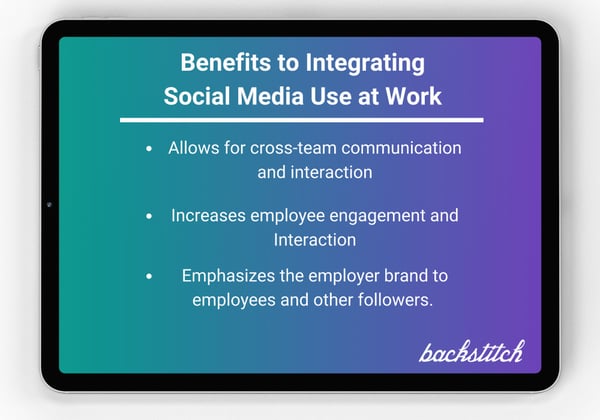Social media has become a pervasive component of everyday life. However, it’s also easy to see why the platforms are attractive. They offer messaging, real-time chat, discussion, information sharing, and event coordination all in one place. During the pandemic, social media means our options for staying in touch with friends and family while physically apart are more convenient than they were in the past.
It’s no small wonder that social media platforms have begun to cross over into the professional arena. Many of the same features that are great for connecting social networks are great for connecting teams. This builds up collaboration across multiple departments.
Yet despite all these benefits, there is a valid cause for concern. Social media platforms are well-known time wasters. Employees tapping into their social media channels on their smartphones are also a productivity and privacy concern.
Issues compound when employees begin to use multiple platforms to stay in the loop. This can increase the risk that people will spend more time staying informed about how best to do their jobs, leaving less time to their jobs.
There are definitely ways in which the benefits of using social media for internal communication can outweigh the risks. However the approach needs to be integrated and interactive with clearly communicated boundaries.
Cross-Team Collaboration
A good social media platform for internal communication facilitates connections across different departments and teams who have historically worked in isolation. Leaders are now aware that teams need to collaborate effectively on projects where their functions overlap. However, dismantling the currently disjointed status quo is easier said than done.
Social media can facilitate cross-team collaboration by making it easy to ask someone a question in real-time. It limits being bothered at a desk or waiting for a meeting. It can make it easy to start a post where information relevant to a shared goal is examined and discussed. It can even include the functionality of being able to tag people whom you especially want to see this information.
A good platform also integrates functions. It saves employees the burden of visiting one place to access policies and forms, another for bulletins and newsletters, and yet another channel for social interaction. A useful platform will be a one-stop spot for all these purposes, ensuring that team social media time is a provider of efficiency, rather than a detractor.
Interactive
The platform should also be interactive and encourage teams to contribute and collaborate on content. This can be a huge enabler of employee engagement. It creates an environment where everyone's unique contributions can enrich the organizational direction and success of the company.
Foster an interactive environment and constructive dynamic. Organizations should establish clear boundaries regarding the purpose and etiquette of the platform.
Employer Brand
When an employee shares specified internal content on social media, it gives the world a peek into company culture. The employee’s friends and family also gain a greater understanding of what they do every single day at work. It promotes positive sentiment for both the employee and the employer. An employer brand, or the reputation that a company has as an employer, is established.
Not only do outside audiences gain a greater opinion of the organization, the worker also improves their personal views. The employee gains a reinforced belief in the company’s mission, values, and culture. All this from merely repeating these internal communications and sharing it with others.

Inclusion of internal communications on social media platforms can become a powerful tool to drive engagement, unity, and success. For more tips on employee engagement, contact us at backstitch today.


